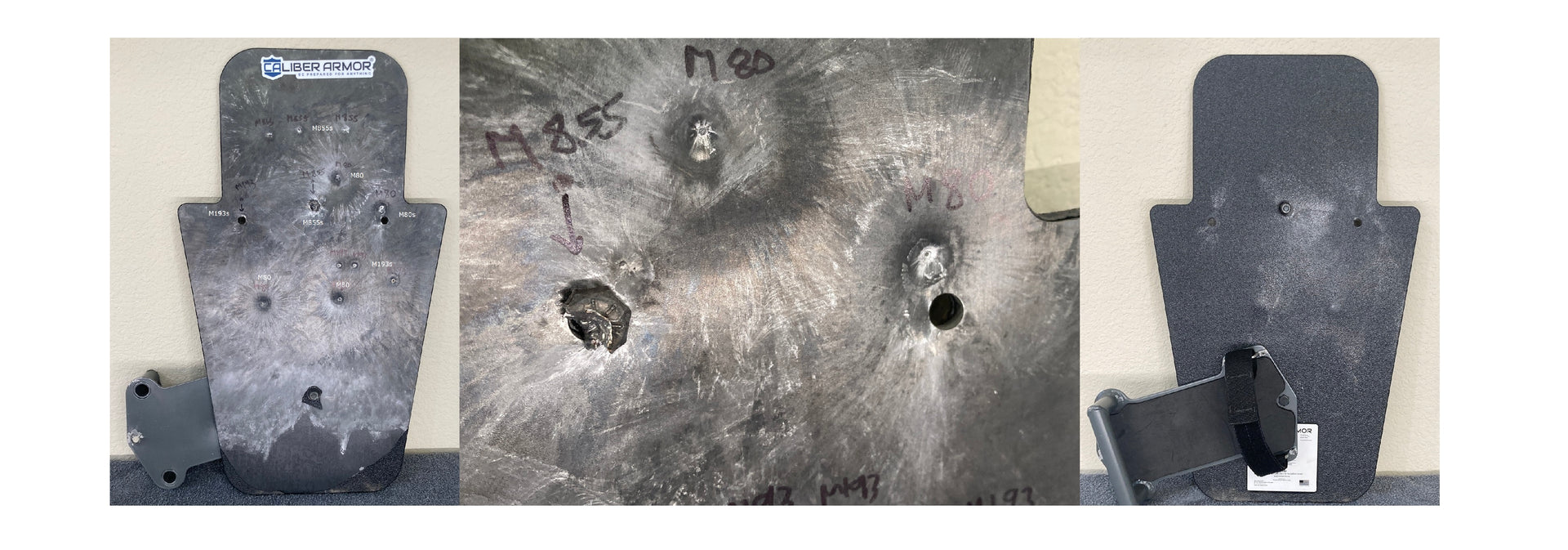Steel Shield Evaluation and Shootout
While Hardcore Defense was the first company to design and market modern steel ballistic shields, other companies making similar products enter and leave the market from time to time. We decided to acquire a couple of current alternatives to our popular Delta Special shield to see how they all compare. Although this assessment was primarily for our internal benchmarking purposes, the results were illuminating so we decided to publish them for the benefit of all.
For the record all testing described below was performed by Hardcore Defense personnel. We use independent labs for verification testing, but they're not suitable for a day-long study of this sort where the test plan is adjusted on the fly depending on the results. All testing was performed according to a pre-established test protocol, all bullet velocities were measured with a chronograph, and all testing was documented by photographs and video recordings.
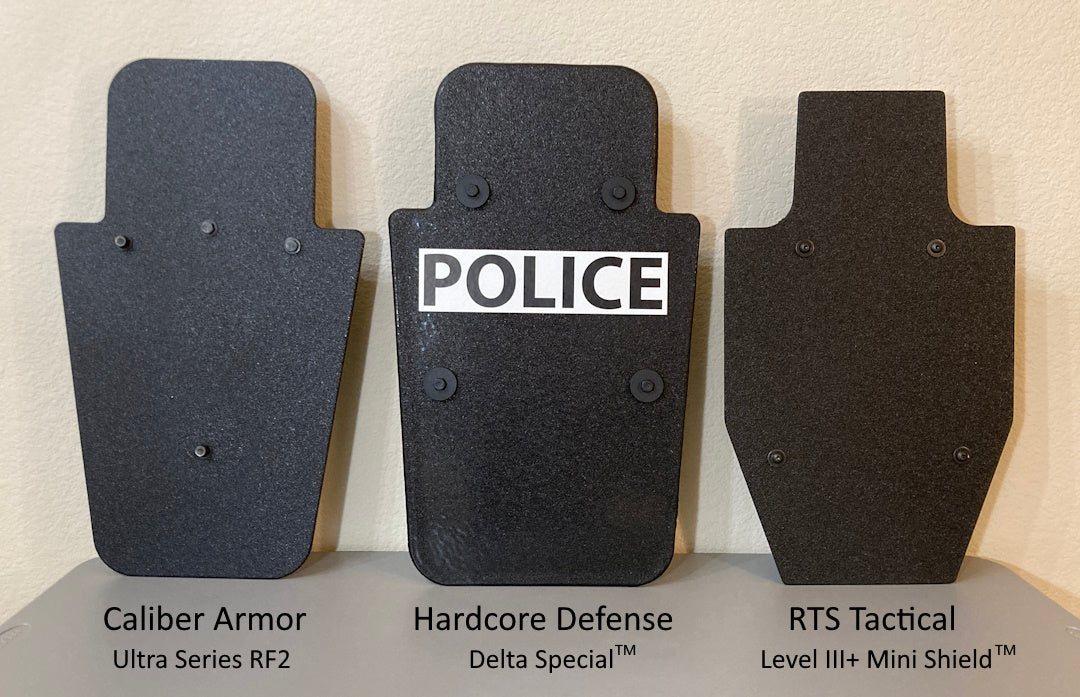
The Candidates
The three shields tested in this evaluation are the Hardcore Defense Delta Special (TM), the Caliber Armor Ultra Series RF2, and the RTS Tactical Level III+ Rifle Special Threats Mini Shield (TM). All three shields are mid-sized shields meant to substantially protect the torso, neck, and head of a single operator. All three shields use a steel ballistic panel with no ceramic or polymer. All three shields are rifle rated. The Delta Special was designed specifically to stop assault rifle rounds. The other two shields use a heavier steel panel capable of withstanding NIJ Level III .308 projectiles. For users facing .308 threats, the Caliber and RTS shields are obviously the right choice. For users concerned with assault rifle threats, the Delta Special provides that protection in a lighter package.
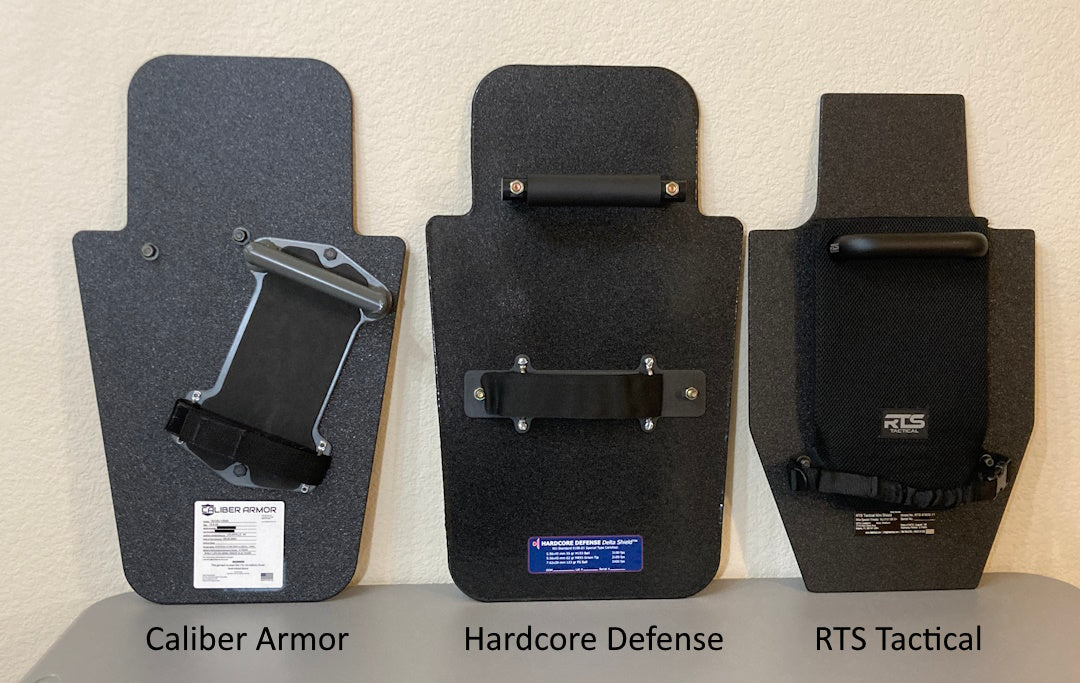
Construction
All three shields are steel core with a polyurea coating. The Hardcore Defense shield uses name brand Rhinolining. The other manufacturers do not specify their coating supplier. Fit and finish on all three shields was very good. The corners of the Hardcore Defense shield were generously radiused, while the RTS Tactical shields were more square cut. The Caliber Armor shield matched the layout and radius of the Hardcore Defense shield although with larger cutouts and tapering.
Hardware - Caliber Armor Ultra Series RF2
The Caliber Armor shield features an adjustable 3-position combined handle, pad, and arm strap assembly. The handle is comprised of 3 pieces of steel tube which are welded to each other and to the base plate, and the entire assembly is powdercoated. The handle is 1" in diameter and unpadded. The foam pad is 1/4" thick and firm.
The handle allows 5" width and 1.25" height for hand clearance. The operator's knuckles are very close to the bolt head. The bolt has been reversed since the locknuts used are significantly taller than the bolt head and would contact the hand.
The arm strap is a 1.5" nylon web and secures to itself with hook-and-loop pads. It can be adjusted to accommodate a forearm up to about 3.5" diameter. The lower bolt has also been reversed since a lock nut would protrude into the user's arm.
Hardware - Hardcore Defense Delta Special
The Delta Special's handle comprises a 1" diameter solid rod made from high impact polymer covered with a medium-soft foam grip pad. Grip diameter measured 1.4". The handle bolts extend all the way through the handle support tubes.
The handle allows 6.5" width and 2" height for hand clearance, the most generous of the three shields. The operator's hand is kept about 1/2"-3/4" away from the ballistic panel.
The arm strap is made from 2" wide nylon webbing and secures to itself with hook-and-loop pads. It can be adjusted to accommodate a forearm up to about 4.5" diameter. The underlying foam pad is 1/2" thick and medium-soft.
Hardware - RTS Tactical Mini Shield
The RTS shield uses an off-the-shelf cast aluminum pull handle. It measures 30 mm top to bottom (1.17") and 26 mm thick on the bearing surface (1.02"). The base of the handle has been tapped and the bolts screw directly into it. The handle has been powdercoated.
The handle allows only about 5.3" width and 1.1" height for hand clearance. It sits over a 1" thick foam pad that keeps the operator's hand well away from the ballistic panel. The foam is firm and covered with a polymer mesh.
The arm strap is made from 1" wide nylon webbing and is secured and adjusted with plastic buckles. Part of the strap has an elastic core and will stretch when pulled on. It can be adjusted to accommodate a forearm up to about 5" diameter. This design provides a less secure anchor since the shield can flop a bit away from the arm as the elastic stretches but the strap can be rapidly released by pinching the clasp on the buckle. The other shields would require perhaps a moment longer to pull the arm out of the strap or peeling open the hook-and-loop connection.
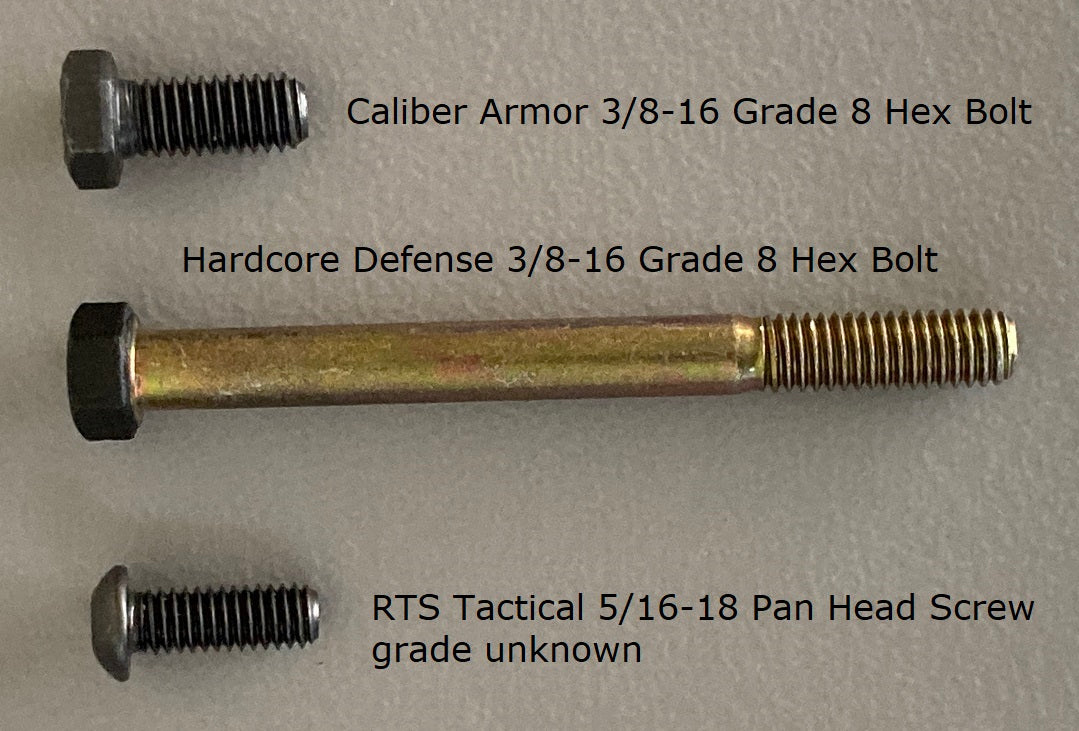
Bolts
The Caliber Armor and Hardcore Defense shields use 3/8" bolts while the RTS Tactical shield uses 5/16" bolts. The Hardcore Defense bolt uses heavy steel reinforcing rings on the strike face of the shield. The other shields use washers under the bolt head.
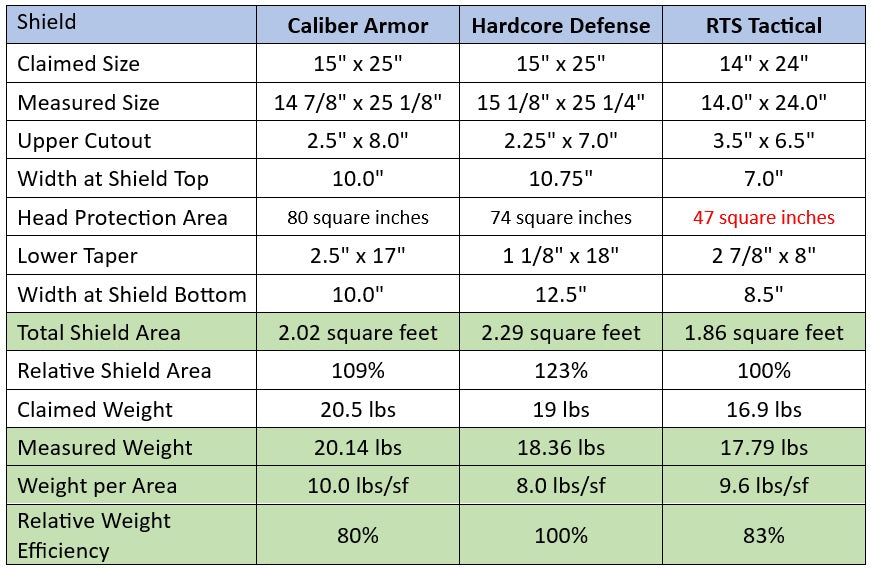
Dimensions and Weight
The width and height of each shield was measured, as were the sizes of the cutouts. The total surface area of the shield was calculated, as well as the area above the shoulders which would protect the operator's head. The RTS shield was the smallest due to its shorter and narrower size and the larger cutouts at the shoulders. Those larger cutouts significantly reduce the head protection area compared to the other shields. The other shields were larger, with the smaller cutouts and tapering of the Hardcore Defense shield resulting in significantly higher surface area than the Caliber Armor shield.
Each shield was weighed. All shields were within +/- 1 pound of claimed weight. The RTS shield was heavier than claimed while the other two shields were lighter than claimed. From a weight per unit area standpoint, the Hardcore Defense shield was superior to the other shields.
Ergonomics
Three different operators handled each of the shields including one who was blinded to which shield was which. The strongest impression of all three evaluators was that the Caliber Armor shield felt top heavy and awkward, with the top of the shield wanting to fall away from the operator and exerting a twisting force on the wrist. This is likely because the center of gravity is about 4-5" offset from the grip and a significant portion of the shield's weight lies above the grip axis.
All operators felt that the Hardcore Defense and RTS Tactical shields felt similar and hung naturally. Two had a slight preference for the Hardcore Defense shield due to the padded handles and wider armstrap. The third operator had no preference between the two.
Ballistic Testing
After the dimensional, weight, and ergonomic assessments were complete we performed ballistic testing on the three shields. All testing was performed per NIJ 0108.1, which is the appropriate method for testing ballistic shields (not 0101.6 which is for body armor!). All testing was performed as per the setup for Level III rifle testing with the test product 49' from the muzzle and the chronograph at 8'. Ambient temperature was 52 degrees Fahrenheit at the start of testing.
Each product was tested versus the test rounds listed in its product claims, where available. For the Caliber Armor and RTS Tactical shields this included the 7.62x51 mm M80 149 grain full metal jacket, the 5.56x45 mm M193 55 grain full metal jacket, and the 5.56x45 mm M855 62 grain green tip. For the Hardcore Defense Delta Special this included the 7.62x39 mm 123 grain FMJ and the two 5.56 mm projectiles listed above.
For the 5.56x45 mm and 7.62x39 mm assault rifle rounds, 3-4 different brands of commercial ammunition and handloads of each type were chronographed and the hottest batches selected for testing. For the 7.62 mm M80, various lots of handloads were tested to determine which best fell between the 2750 (Level III) and 2780 fps (RF2) nominal velocities when fired from the test rifle.
- IMI factory ammo was used for the 5.56x45 mm M193 testing. The test firearm was an AR15 with 20" barrel.
- Winchester factory ammo was used for the 5.56x45 mm M855 testing, using the same firearm as above.
- Bear factory ammo was used for the 7.62x39 mm FMJ testing, using a Ruger Mini-30 with 18.5" barrel.
- A .30-06 with 24" barrel was used for the M80 testing, with the projectiles handloaded to meet the target velocities as described above.
We fired three of each test round against each shield, aiming for a mid-panel hit away from the hardware, the edge of the panel, and any prior hit. We also fired one of each test round against a bolt head, and a second round aiming immediately adjacent to the bolt head. In our experience these areas are where poorly designed shields typically fail.

Caliber Armor
The Caliber Armor shield withstood all shots against the ballistic panel without any cracks or penetrations. The coating was not well adhered to the steel and progressively delaminated with each hit.
Both 5.56 mm shots against the bolt heads damaged or broke the hardware resulting in the handle swinging loose from the shield and compromising the utility of the shield. The M80 strike blasted the bolt through the shield.
The shots adjacent to the bolt heads did not cause any cracks or penetrations.

RTS Tactical
The RTS Tactical shield withstood all shots against the ballistic panel without any cracks or penetrations. The coating remained well adhered to the steel.
All shots against the bolt heads blasted the bolts through the shield causing the handle to come loose and the arm strap to be severed. This would compromise the utility of the shield, in addition to any injuries sustained from the penetrations.
The 5.56 mm shots adjacent to the bolts did not cause any cracks or penetrations. The M80 shot adjacent to the bolt cracked the panel, but this was a hot round more than 100 fps above the target velocity. Disregard this strike.

Hardcore Defense
The Hardcore Defense Delta Special shield withstood all shots against the ballistic panel without any cracks or penetrations. The coating was well adhered to the steel but exhibited uncharacteristic flaking from both the backface and at the perimeter of the shield.
All shots directly against and adjacent to the bolt heads were stopped without any of the bolts fracturing. The reinforcement rings were damaged (as per design) but there was no damage to the ballistic panel. The handle was slightly loose with about 1/4" of play but the shield was still functional.
For reasons unknown all three M855 shots against the bolt head missed. Based on our prior testing and testing the Caliber shield's similar 3/8" Grade 8 bolt we are assured that the bolt would not break if hit directly by an M855 projectile. However one strike caused the screw holding the arm strap anchor to break resulting in a loose strap. This would likely cause a distraction during use of the shield but due to the balance of the shield it would remain functional (the many owners of the basic Delta Shield can confirm the shield works just fine without the arm strap).
Note that we had some excess ammo and opted to shoot an additional four M193 shots against the Delta Special. None caused cracks or penetrations.
Summary
Physical Assessment: All three shields generally matched their specifications with respect to dimensions and weights. The Hardcore Defense shield has the largest frontal surface area at 2.3 square feet followed by the Caliber Armor shield at 2.0 sf and the RTS Tactical shield at 1.9 sf. The Caliber Armor shield measured at 20 lbs while the other shields were a noticeably lighter 18 lbs.
Ergonomic Assessment: The Caliber Armor shield was judged to be top heavy and awkward to carry compared to the other shields. The steel pipe grip was also not favored and may be uncomfortable to use in very hot or cold weather. The Hardcore Defense and RTS Tactical shields were more comfortable to carry, with the edge going to the Hardcore Defense shield with the padded grip and generous arm strap.
Ballistic Assessment: All three shields were able to withstand multiple hits from the key test rounds against the shield panels.
With respect to shots against the shield hardware, both 5.56 mm rounds damaged the Caliber Armor hardware causing the handle to come loose, while the heavier M80 round blasted the bolt through the shield, an event which could result in serious injury to the user. The RTS Tactical shield uses an even lighter bolt and all strikes against the hardware resulted in the bolt fracturing and the shaft being blown backwards through the panel. Only the Hardcore Defense shield was able to withstand strikes against the hardware without loss of shield function or risk of injury to the user. Our patented design enables this performance.
The polyurea coating on the Caliber Armor shield was not well adhered to the steel and delaminated when hit. This would not impact the function of the shield but having flaps of polymer hanging off the shield after several hits is not ideal.
The Rhino coating on the Hardcore Defense shield showed a tendency to flake when the shield was hit. While also a cosmetic and not a functional issue, this is not something we have observed before despite many years of testing. We traced the problem to this shield having been coated with the tail end of a coating material batch and there were traces of material precipitation in one of the drums. We have implemented corrective actions. Likewise the broken screws anchoring the arm strap is something we haven't seen before. However we recently updated the arm strap anchor assembly design (the test shield used the older design) and the new design uses a thicker anchor bar and heavier screw which should resolve the problem. We will test to confirm.
Note that the 5.56x45 mm velocities for both the M193 and M855 rounds were less than those called out for by the RF2 draft standard; it is unknown if the Caliber Armor shield can consistently withstand M193 hits in the 3220-3280 fps range as claimed. Typically this requires a greater steel thickness than is used by Caliber, according to our own testing (which is why the Bravo has a titanium strike face) and per input from a couple of ballistic steel vendors we've talked with. If we get a chance we'll handload some extra hot rounds and perform testing.
Caveats
This study evaluated only one shield of each type. While any company using a reputable ballistic steel vendor with good quality control will receive generally consistent product, each lot of steel does vary slightly with respect to thickness, hardness, and impact strength. Likewise the same lot of ammunition fired from the same test firearm at different times may yield different velocities which may impact test results. The results of this study may or may not be applicable to other products manufactured by the same company or tested under different conditions.






